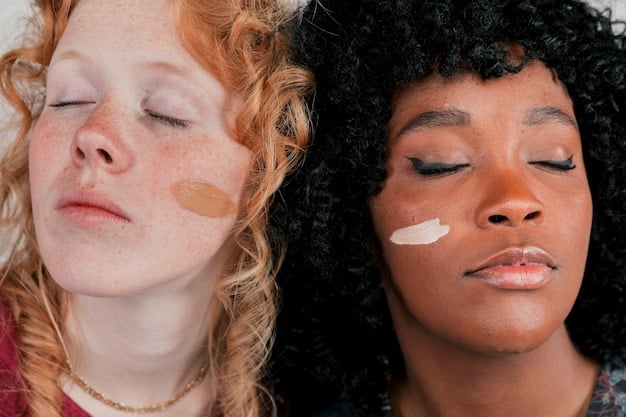Understanding Undertones: Your Guide to Choosing the Perfect Foundation

Understanding undertones is crucial in selecting the right foundation. By identifying whether you have warm, cool, or neutral undertones, you can ensure your foundation complements your skin perfectly, creating a flawless, natural look.
Finding the perfect foundation can feel like navigating a maze, doesn’t it? One of the most important factors often overlooked is understanding undertones. So, how do you ensure your foundation truly matches your skin? It all starts with identifying your undertones.
This guide will help you decode your skin’s undertones and choose the right foundation for a flawless, natural finish. Let’s dive into the secrets of understanding undertones for a perfect makeup match!
Understanding Undertones: A Key to Flawless Foundation
Choosing the right foundation color goes beyond just matching the surface shade of your skin. Understanding undertones is the secret to that seamless, natural look we all strive for. Your undertone is the subtle hue beneath the surface of your skin that influences how a foundation will appear.

What Are Undertones?
Undertones are the constant hues beneath the surface of your skin. They’re different from your skin tone, which can change due to sun exposure or skin conditions. Undertones remain consistent and fall into three primary categories:
- Warm Undertones: Characterized by hints of yellow, peach, or gold.
- Cool Undertones: Display subtle hues of pink, red, or blue.
- Neutral Undertones: A balance of warm and cool, or an absence of prominent underlying hues.
By understanding these categories, you can better navigate the countless foundation options and select one that truly complements your complexion.
In summary, understanding undertones can significantly enhance your makeup application, ensuring a more natural and harmonious look. Getting to know this aspect of your skin is the first step towards finding your perfect foundation match.
How to Identify Your Undertones for Perfect Foundation
Now that we know what undertones are, how do we figure out which one we have? Determining your undertone can seem tricky, but there are a few proven methods you can use for understanding undertones and selecting the right foundation.
The Vein Test
One popular method is the vein test. In natural light, examine the veins on your wrist:
- Blue or Purple Veins: Suggest cool undertones.
- Green Veins: Indicate warm undertones.
- Blue-Green Veins: Usually mean you have neutral undertones.
The Jewelry Test
Another useful method is evaluating how your skin looks with different types of jewelry:
- Gold Jewelry: If gold jewelry makes your skin look radiant, you likely have warm undertones.
- Silver Jewelry: If silver jewelry complements your skin better, you probably have cool undertones.
- Both Look Good: You may have neutral undertones.
These tests are a great starting point for understanding undertones. Armed with this knowledge, you’re one step closer to finding a foundation that harmonizes with your natural complexion.
Matching Foundation to Your Skin Tone and Undertone
Once you’ve identified your undertone, the next step is to match your foundation accordingly. This involves considering both your skin tone (fair, light, medium, tan, deep) and undertone (warm, cool, neutral) to achieve a seamless look. It is important for understanding undertones in order to choose the correct color and shade.
Foundations for Warm Undertones
If you have warm undertones, look for foundations described as:
- Yellow-Based: These foundations enhance the natural warmth of your skin.
- Golden: Impart a radiant glow that complements warm undertones.
- Peach-Toned: Offer a soft, natural finish.
Foundations for Cool Undertones
For those with cool undertones, consider foundations that are:
- Pink-Based: Neutralize any sallowness and brighten the complexion.
- Red-Based: Add a touch of warmth while complementing cool undertones.
- Blue-Based: Reduce redness and create a balanced look.
Foundations for Neutral Undertones
If you have neutral undertones, you can often wear a wider range of foundation shades. However, here are some suggestions:
- Balanced: Foundations without a strong leaning towards warm or cool.
- Olive: Work well for neutral-warm undertones.
- Beige: Provide a natural look without altering the skin’s natural hue.
Matching foundation to both your skin tone and undertone ensures a flawless, natural finish. The key is understanding undertones and how they interact with different foundation formulations and colors.
Common Mistakes When Choosing Foundation Bases
Choosing the wrong foundation base is a common mistake that can lead to an unnatural or unflattering look. Understanding undertones plays a crucial role in avoiding these mishaps. Let’s explore some frequent errors and how to steer clear of them.

Ignoring Undertones
One of the biggest mistakes is ignoring your undertones altogether. Simply matching the surface color of your skin can result in a foundation that looks ashy, orange, or unnatural. Always consider your undertone when selecting a foundation.
Testing Foundation Incorrectly
Many people test foundation on their hand or wrist, which often doesn’t match the skin on their face. The best approach is to test a small amount on your jawline in natural light to see how it blends with your skin. This ensures a more accurate match and helps in understanding undertones effectively.
Not Considering Oxidation
Oxidation is when a foundation changes color after it has been applied to the skin. Some foundations may darken or become more orange as they react with the body’s natural oils. To avoid this, ask for a sample and wear it for a few hours to see how it oxidizes before purchasing.
Avoiding these common mistakes and understanding undertones will set you on the path to finding the perfect foundation. Taking the time to properly test and consider your skin’s unique characteristics will yield the best results.
Tips for Testing Foundation Effectively for Undertones
Effectively testing foundation is crucial to find the perfect match for your skin tone and undertone. Here are some actionable tips to help you make the right choice. Correctly understanding undertones is essential.
Test in Natural Light
The best place to test foundation is in natural light. Artificial lighting can distort the color and make it difficult to see how the foundation truly looks on your skin. Step outside or near a window to get the most accurate representation.
Apply on Your Jawline
Instead of testing foundation on your hand or wrist, apply a small amount to your jawline. This area provides a more accurate representation of how the foundation will look on your face, as it matches both your face and neck color.
Wear It for a Few Hours
Once you’ve applied the foundation, wear it for a few hours to see how it oxidizes and settles on your skin. This will give you a better idea of whether it darkens, becomes oily, or remains true to color. This is essential to understanding undertones.
These testing tips, combined with a good grasp of your undertones, will significantly improve your chances of finding a foundation that looks flawless and natural. Taking the time to test thoroughly, and understanding undertones will save you from disappointing purchases.
Maintaining Your Foundation Look Throughout the Day
Once you’ve found the perfect foundation match, it’s important to maintain that flawless look throughout the day. Ensuring your foundation stays put and looks fresh requires a few key steps and products. Understanding undertones combined with the right maintenance techniques will help you rock your perfect base.
Use a Primer
A primer creates a smooth base for your foundation, helping it to adhere better to your skin and last longer. Choose a primer that suits your skin type – hydrating for dry skin, mattifying for oily skin, and smoothing for mature skin.
Set with Powder
Setting your foundation with a translucent powder can help to lock it in place and prevent it from moving or creasing throughout the day. Use a light hand and a fluffy brush to apply the powder, focusing on areas that tend to get oily.
Blotting Papers
Carry blotting papers with you to absorb excess oil throughout the day without disturbing your makeup. Gently press the blotting paper onto your skin to remove shine and keep your foundation looking fresh.
By incorporating these maintenance tips into your routine, you can ensure that your foundation stays flawless from morning to night. With the perfect match and the right techniques, you’ll feel confident and radiant all day long. You have the tools to keep understanding undertones as an important part of your daily routine.
| Key Point | Brief Description |
|---|---|
| 🔍 Determine Undertone | Use the vein or jewelry test to identify if you have warm, cool, or neutral undertones. |
| 🎨 Match Foundation | Select foundation shades based on your undertone: yellow/golden for warm, pink/red for cool, and balanced for neutral. |
| 💡 Test Properly | Test foundation on your jawline in natural light and check for oxidation. |
| ✨ Maintain Look | Use primer, set with powder, and blot excess oils to keep your foundation fresh all day. |
Frequently Asked Questions
Understanding your skin’s undertones ensures your foundation complements your complexion, providing a seamless and natural look, and avoiding an ashy or orange appearance.
The main types of undertones are warm (yellow, peach, golden), cool (pink, red, blue), and neutral (a balance of warm and cool, or neither is prominent).
You can use the vein test (blue/purple veins indicate cool, green indicates warm) or the jewelry test (gold looks better on warm, silver on cool) to determine your undertone.
If you can’t find a perfect match, consider mixing two foundations with different undertones to create a custom blend that suits your skin perfectly.
Oxidation can cause foundation to change color. Always test a sample on your skin for a few hours to see if it darkens or changes shade after application, and before making a purchase.
Conclusion
Understanding undertones is essential for choosing the right foundation. By identifying your undertones and following the tips outlined in this guide, you can say goodbye to mismatched makeup and hello to a flawless, natural complexion.
Remember to test, test, test! A little extra effort in selecting your foundation will pay off with a radiant look every time. Now that you know how to identify your undertones, understanding undertones will be easier and you can confidently choose the perfect base!





